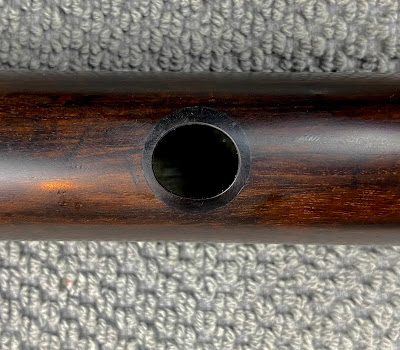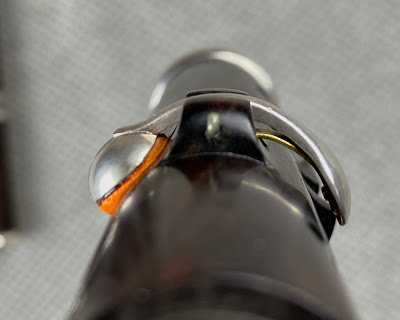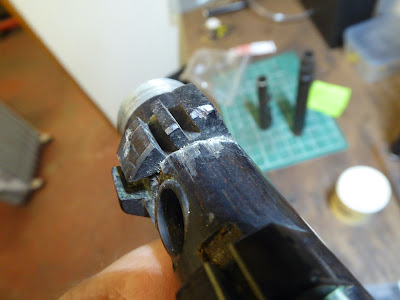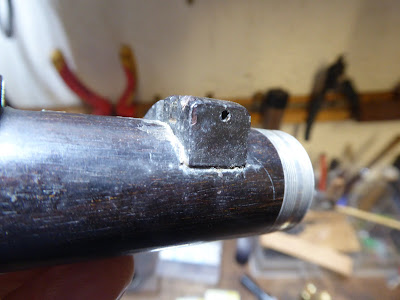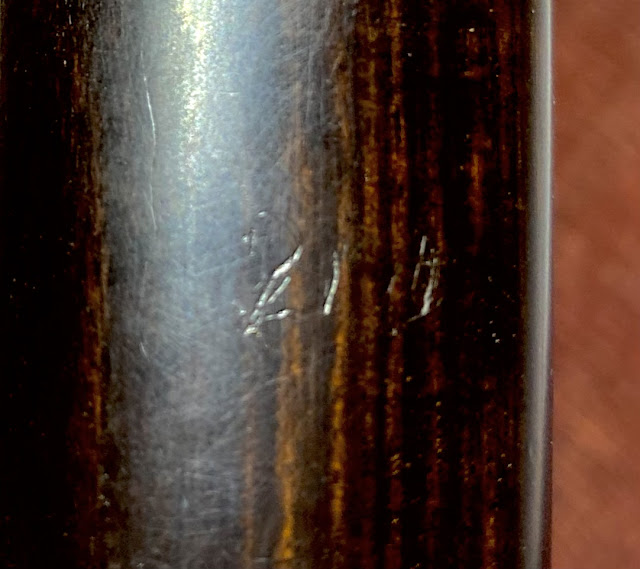I've been recently working on Rudall & Rose 3411, and it revealed a few things that even an experienced restorer might miss.
This flute is in essence a standard instrument of the period, cocus, 8 silver keys, repaired crack in the head (through the embouchure)
One aspect is unusual though. Note that the low C# and C keys, which on R & R flutes are almost exclusively pewter plugs, are here padded cups.
More on that later.
This flute was in generally very good condition, and not only that, it was clear that the work done on the flute was of a high standard. The head crack was beautifully repaired, except that it had failed to return the embouchure to its original shape, as the crack had just been filled, with no attempt to close it. Unusually, the crack had been filled with dark coloured shellac, something that I've never seen before, and even though there was no pinning of any sort, it had remained very stable. There were a couple of other minor and totally resolvable issues, a poorly reattached half of the G# block, and standard padding and joint problems.
The flute, even with the slightly distorted embouchure played quite well, but it was decided to try and resolve the distorted embouchure, by the standard method of pulling the head liner, clamping the crack closed, re-reaming to re-admit the liner, and glueing it in place with epoxy. This done, the embouchure distortion was still evident, and playability had not improved.
I decided to check for other factors that might be affecting this. One the most commonly missed, although easily found (if that makes sense) problems, is what I've come to call a "Fitzharris" leak.* In essence this is caused by air being able to pass between the head liner and the wood of the head, the air entering this gap when the player blows across/into the embouchure. What makes this type of leak so insidious, is that the effects are very subtle, and it's not easy to detect by the usual methods such as the blow/suck test. In fact in many cases, even a Magnahelic leak detector will not show it.
The only reliable way to detect these leaks should be evident from watching the video here...much easier than trying to explain in words.
Finding the leak is one thing. Doing something about it is another. As with all leaks this involves physically preventing the passage of air from the bore to the outside, but in this case the location of where the leak reaches the outside, essentially at the bottom of the recess into which the protruding barrel liner goes when the slide is closed, makes resolving it a far from simple proposition.
On occasions, it is possible to solve a leak like this by blocking it at the embouchure, particularly where a gap between the liner and the wood can be seen at this point. The idea here is to use low viscosity CA glue and let it wick into the gap. It has to be said that this only works very occasionally.
Otherwise, the idea is to use essentially the same technique to block the leak from inside, the difficulty here being how to get the "blocking agent" to the site of the leak. Here is not the place to describe how this can be done in great detail, suffice to say that access to the bottom of the recess is of overriding importance.
In the case of R & R #3411 I'm fairly certain that the Fitzharris leak was exacerbated by the crack through the embouchure. Think about it. A crack goes all the way through the wall of the flute. In an attempt at repair, the crack is filled from the outside, but if this is done with a material of too great a viscosity, even if the crack has been pinned, there is every chance of leaving a channel for air to pass between the head liner and the wood of the head at the bottom of the crack.
As I had decided in this case to re-do the crack repair, I had hoped that this in itself would solve the leak, but it was not to be the case. However, I did manage to seal the Fitzharris leak.
The result of this was disappointing. The flute played marginally better, but certainly not to the level to which I knew it was capable, so now I began to check the whole flute for other issues.
The title of this post implies that there's more to look at here than leaks, and in fact it was in admiring some of the great workmanship on this flute that I came across another unusual problem, the solution of which went a long way to finally getting the instrument back to its full potential. I had removed a couple of the double springs to deal with a little rust and dirt that had accumulated around them, and noticed that instead of the normal flat surface underneath the double spring, that whoever was keying the flute...stringing it in flute maker's parlance...had left the spring protrude over a little shelf or step, about 0.2-0.3mm in depth, which formed a fulcrum over which the spring could flex, the idea being, I presume, to make the action of the spring more precise.
Note from this image, that the springs are held in place with tiny screws, and of course holes must be drilled in the flute body to receive the screw, which is what we would call nowadays a self tapper.
Having solved the leak in the head, without any great improvement in playability as noted above, I began to look for other sources of leaks, using the Magnahelic leak detector. This device allows the user to detect very small changes in pressure, such as would result from a leaking key for example. I promise that I'll shortly do a post about this type of leak detector, how it works, and how to make one, but for the moment suffice to know that the gauge reads effectively zero if the output of air from it is blocked, as in a closed tube or a non leaking flute, and around 6-7 on an open tube or a badly leaking flute. Interim figures show a flute that is leaking to various degrees. Imagine my surprise then, when I checked the left hand ( upper middle) joint of the flute, and got a figure of 6 on the gauge! Pressing the keys down individually, which will often show which one is leaking had no effect. The keys were removed, and holes sealed with plasticene...and the gauge still read 6. Remember this was a flute that was playing down to the low C, admittedly not very strongly. Cue some serious head scratching.
There are two other potential sources of leaks, which although rare, and most often found on low quality instruments, I have encountered before. Both of these involve what are supposed to be blind holes, i.e. they don't reach the bore. The first of these is the small hole you can see in the photo here.
This hole holds the small cork bumper which prevents the key clicking against the body of the flute, and is usually situated under the spring rivet. It's normally about 2.5mm in diameter. I've on occasions come across one of these holes which has been drilled too deeply, but given the size of the hole this usually produces a very obvious leak. This needed to be eliminated though, so Plasticene was again employed to seal these holes (the bumpers themselves having been removed) but to no avail - still 6 on the gauge. It was only after I had removed the double springs that I thought of the little holes for the screws holding them in place. Sometimes it's possible to see where a hole like this penetrates the bore simply by looking up the bore against a bright light, when the hole can be seen as a small dark spot against the polished surface, but not in this case. So I tried probing the spring screw holes with a needle, and although the G# was fine, the Bb screw hole allowed the needle point to pass into the bore.
Was this my leak? A small nubbin of Plasticene was soon applied, this time to great effect. I had a different flute in my hand.
Sealing this leak permanently was simply a matter of introducing some CA glue into the hole, Not to the extent that the hole was completely "filled in", letting it harden, and reattaching the double spring with the original screw.
Finally, even though sorting all the non too obvious leaks, had improved the flute immensely, I decided to bush the embouchure, which I did with some nice black horn from our local buffalo herd. This was the final improvement...the flute was back to its wonderful best.
One final observation.
Although there is at least one other flute by Rudall & Rose ( # 1418 ) that has padded C and C# keys, this one, in contrast to #1418 has obviously been modified from original pewter plugs. Here's an image of #1418, where you can clearly see the machined pad seatings under the C and C#.
What I found interesting is that this conversion of the striker plates to accept pads on #3411 has been done in a very sophisticated way. Have a look at this image...
The original striker plate was completely flat, and the seal, when closed, was formed by the taper ( normally 60 deg. ) on the pewter plug, fitting into the similar taper on the striker plate. You can see in the image, that in order to form seating suitable for a pad, that the striker plate has been machined to produce a raised edge that will form the necessary impression on the pad. Note also, that though the screws which hold the striker plate in place impinge on the machined surface, they must have been removed before the seating was machined, and replaced afterwards. It's beautifully done.
I think it came out well.
* Flute virtuoso Tommy Fitzharris came to me with several flutes that had this problem. He figured out this way of demonstrating it. Remarkably, it requires quite a bit of blowing pressure to produce the bubbles, much more than the blowing pressure when playing. Something strange is going on acoustically here.























